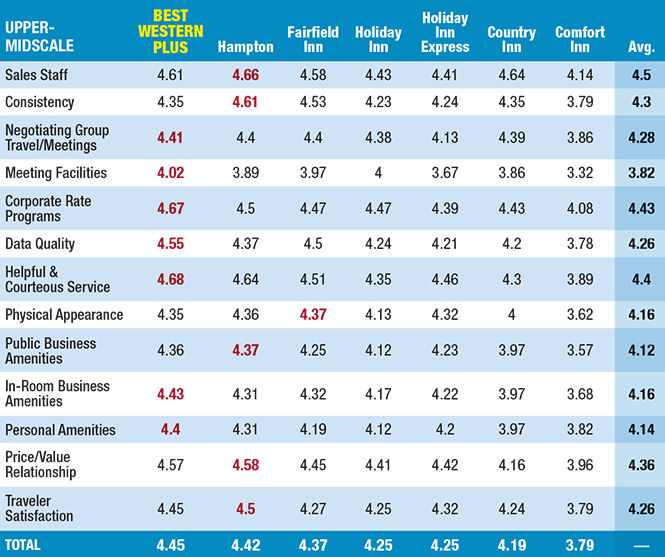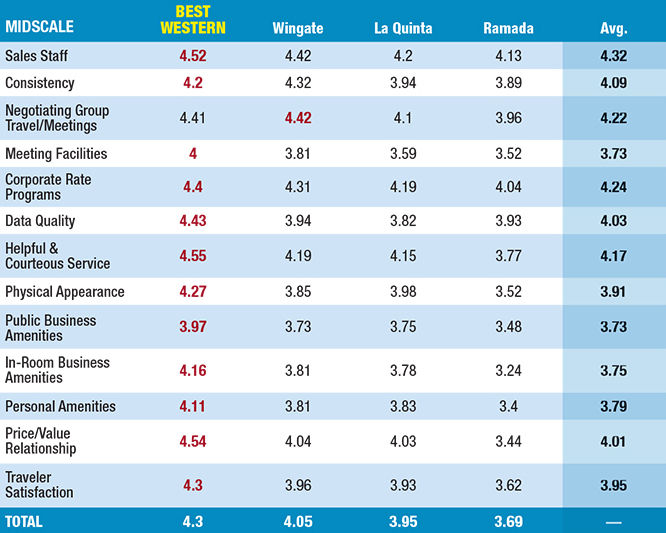In the upper-midscale and midscale segments, hoteliers face the
difficulty of meeting the expectations of ever-more-discerning guests while working
with lower operating budgets than their upscale and luxury counterparts. The top
performers in this year's survey for the upper-midscale and midscale segments have
embraced both guest-facing and staff-facing technologies to meet the challenge.
Best Western Hotels & Resorts' Best Western Plus led the
upper-midscale segment, earning the highest scores for such criteria as ease of
negotiating group travel and meetings, facilities for meetings, corporate rate programs,
data quality and helpful and courteous service. Its Best Western brand performed
even better in the midscale segment, garnering the highest scores for nearly every
category.

The company is in its second year of a partnership with Mursion
to provide onsite virtual reality training for front desk staff. The simulations
of real-life customer interactions, which are based on real Best Western guest data,
enable personnel to refine their communication skills and practice resolutions for
common problems. The front desk agents "actually are being tested while learning
in a much more fun environment," said Best Western Hotels & Resorts chief
marketing officer and SVP Dorothy Dowling.
VP of worldwide sales Wendy Ferrill said the company takes a
holistic approach with corporate clients, ensuring that the transient travel, loyalty
and meetings aspects of the business all work together. "Really, it's all about
the focus on the buyer first and what outcomes and goals the travel program is trying
to achieve," she said. As such, the company caters its Best Western Rewards
offerings to corporates, communicating with travelers through travel managers and
offering incentives and promotions geared toward business travelers "as opposed
to just blanket offers like a lot of the other brands and chains do," Ferrill
said. She said the product offering focuses on functional rooms with intuitive design
and high-speed Wi-Fi.
More on Upper-Midscale Brands
Ranking at No. 2 in the upper-midscale segment, Hampton by Hilton
earned top marks for traveler satisfaction, price/value relationship, public business
amenities, consistency of offering and sales staff.
Phil Cordell, Hilton global head for focused service and Hampton
brand management, said the brand has worked with its hotels to enhance local sales
efforts. The approach, he said, provides "boots-on-the-ground resources and
support for our sales leaders and value to our hotel owners." Hampton, too,
has shifted to a virtual training program, enabling sales team members to maintain
productivity and learn in a modern environment without leaving their hotels.
A little over a year ago, Hampton updated its rooms' interior
design in response to guest research and design trends. The brand is rolling out
Digital Key mobile entry through the Hilton Honors app, and 30 percent of the portfolio
will have Digital Key capabilities by year-end. In the year ahead, Hampton also
plans to roll out a new hotel design, updated food and beverage programs and enhanced
service strategies. It also will open 160 new hotels globally.
Third-place finisher Fairfield Inn earned the highest score in
the upper-midscale segment for physical appearance of hotels. Portfolio-wide renovations
and a prototype for new-build properties that features flexible, modern workspaces
for travelers have garnered high guest satisfaction scores internally on par with
some of the luxury hotels in its Marriott family, according to VP of Fairfield brand
management Callette Nielsen. The brand also has rolled out digital check-in, as
well as service requests through the Marriott Rewards app across its hotels. The
brand debuted in China this year and expects to open more than 100 properties there
during the next five years.
From January to July, upper-midscale's average daily rate increased
1.4 percent year over year to $113.23, according to STR. Occupancy decreased 0.1
percent 68.4 percent. The segment is beginning to see the impact of 3.1 percent
supply growth outpacing 3 percent demand growth.
More on Midscale Brands
Wingate by Wyndham came in second place in the midscale tier
for BTN's survey but, for the third consecutive year, came in first in the J.D.
Power 2017 North America Hotel Guest Satisfaction Index Study. In BTN's survey,
it earned the highest score of the segment for ease of negotiating group travel
and meetings.

VP of brand operations Aly El-Bassuni said the brand recently
tested a program to support sales in which a third party provides a dedicated team
for RFPs, inbound sales calls and outbound lead generations. The program is in place
at 20 percent of Wingate properties and is "generating really strong results,"
El-Bassuni said.
Wingate's prototype calls for a boardroom meeting facility and
small and midsize meeting facilities at each property. That's a differentiator in
the midscale segment, which tends toward smaller meeting facilities, and El-Bassuni
said Wingate has benefited from savings-conscious corporates that have moved down-segment
for meetings.
El-Bassuni said the brand is in the midst of a strong growth
year "with some really strong, quality conversions." For every two new-construction
properties, the brand also is opening a conversion property, he said, which has
helped the brand grow into some major urban markets.
From a guest-facing perspective, Wingate benefits from its affiliation
with Wyndham Rewards. Last year, the company made it more straightforward to earn
points and redeem free nights at Wyndham Worldwide properties. Wingate also is testing
Google Chromecast-powered StayCast at half a dozen properties. The technology allows
guests to stream TV shows and movies via apps like Netflix, Hulu and YouTube.
"What's really staggering is the amount of streaming that guests are engaging
in," El-Bassuni said. "On an average length of stay just shy of two nights,
we're seeing guests streaming at those six facilities almost five hours. We're seeing
very strong engagement."
From January to July, midscale ADR increased 1.7
percent to $87.08 year over year and occupancy grew 0.7 percent to 60.5 percent,
according to STR.